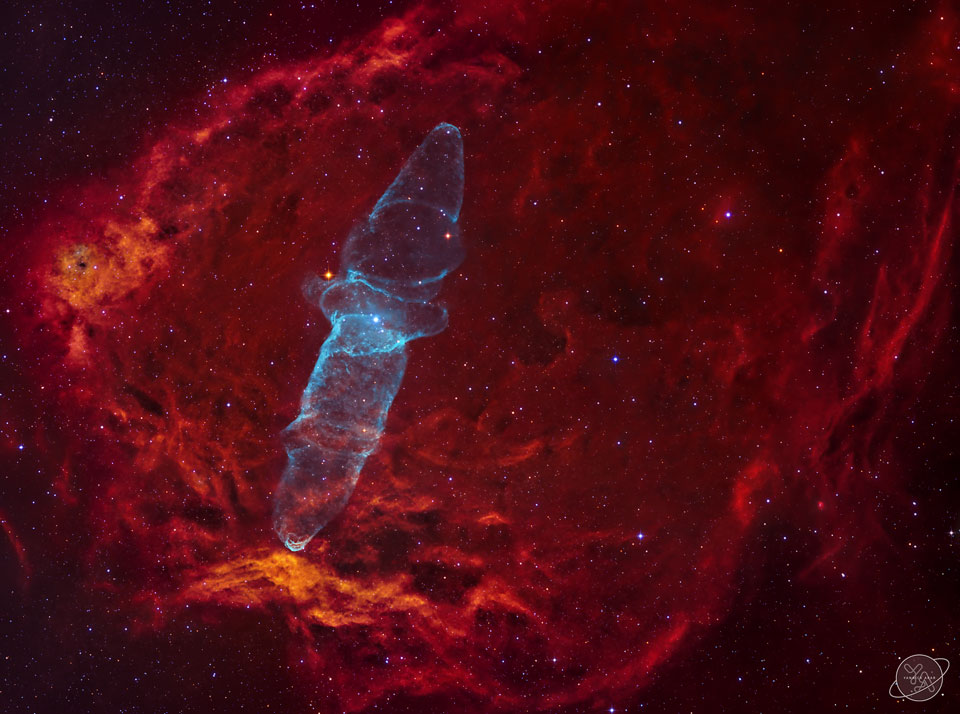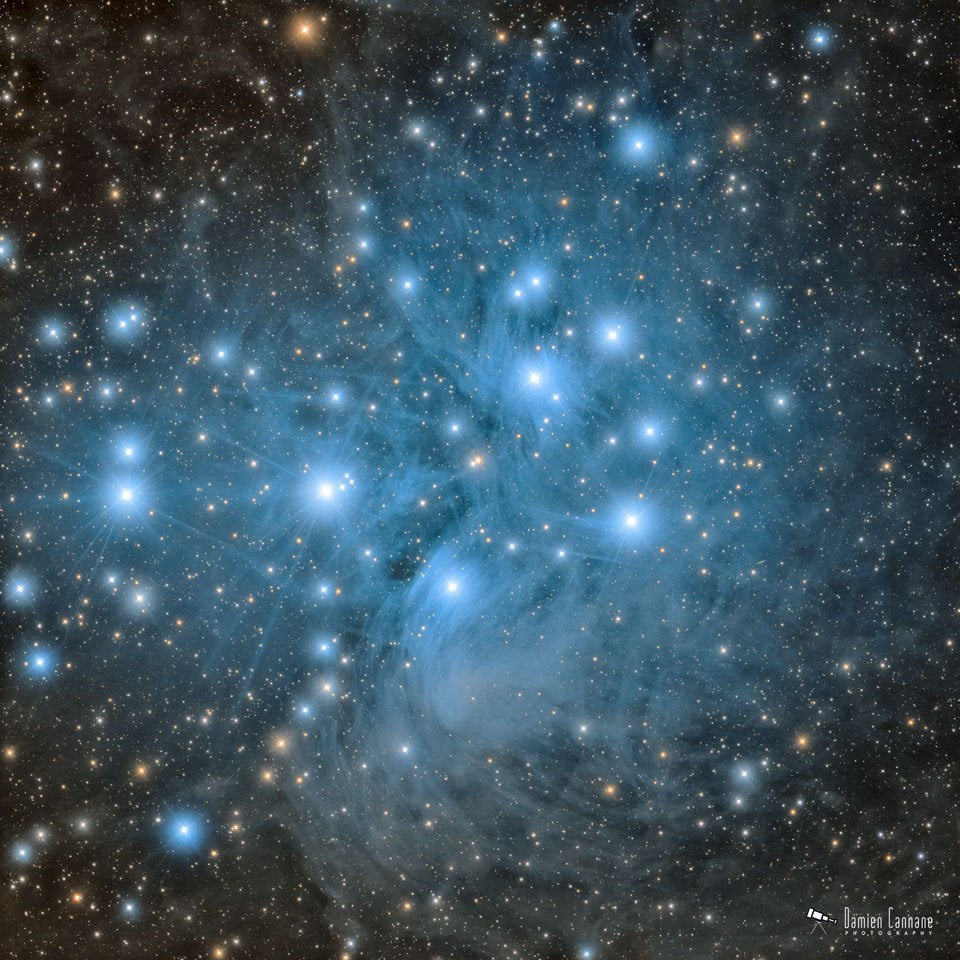Blog
A very faint but very large squid-like nebula is visible in planet Earth’s sky — but inside a still larger bat. The Giant Squid Nebula cataloged as Ou4, and Sh2-129 also known as the Flying Bat Nebula, are both caught in this cosmic scene toward the royal royal constellation Cepheus. Composed with 55 hours of narrowband image data, the telescopic field of view is 3 degrees or 6 Full Moons across. Discovered in 2011 byFrench astro-imager Nicolas Outters, the Squid Nebula’s alluring bipolar shape is distinguished here by the telltale blue-green emission from doubly ionized oxygen atoms. Though apparently completely surrounded by the reddish hydrogen emission region Sh2-129, the true distance and nature of the Squid Nebula have been difficult to determine. Still, a more recent investigation suggests Ou4 really does lie within Sh2-129 some 2,300 light-years away. Consistent with that scenario, Ou4 would represent a spectacular outflow driven by HR8119, a triple system of hot, massive stars seen near the center of the nebula. The truly giant Squid Nebula would physically be nearly 50 light-years across.

Nathaniel Carlyle Adderley (November 25, 1931 – January 2, 2000) was an American jazz trumpeter. He was the younger brother of saxophonist Julian “Cannonball” Adderley, whom he supported and played with for many years.
Adderley’s composition “Work Song” (1960) is a jazz standard, and also became a success on the pop charts after singer Oscar Brown Jr. wrote lyrics for it.
Adderley was born in Tampa, Florida, but moved to Tallahassee when his parents were hired to teach at Florida A&M University. His father played trumpet professionally in his younger years, and he passed down his trumpet to Cannonball. When Cannonball picked up the alto saxophone, he passed the trumpet to Nat, who began playing in 1946. He and Cannonball played with Ray Charles in the early 1940s in Tallahassee and in amateur gigs around the area.
more...Paul Desmond (born Paul Emil Breitenfeld, November 25, 1924 – May 30, 1977) was an American jazz alto saxophonist and composer, best known for his work with the Dave Brubeck Quartet and for composing that group’s biggest hit, “Take Five“. He was one of the most popular musicians to come out of the cool jazz scene.
In addition to his work with Brubeck, he led several groups and collaborated with Gerry Mulligan, Chet Baker, Jim Hall, and Ed Bickert. After years of chain smoking and poor health, Desmond succumbed to lung cancer in 1977 after a tour with Brubeck.
Desmond was born Paul Emil Breitenfeld in San Francisco, California, in 1924, the son of Shirley (née King) and Emil Aron Breitenfeld. His grandfather Sigmund Breitenfeld was, according to an obituary, born in Austria in 1857. Sigmund Breitenfeld, a medical doctor, emigrated to New York City with his wife Hermine (born Hermine Lewy) at the end of the 19th century, and the Breitenfelds raised their four children (including Desmond’s father Emil) with no religion. Interviewed by Desmond biographer Doug Ramsey, Desmond’s first cousin Rick Breitenfeld said that no one in the Breitenfeld family could find evidence of Jewish ancestry or Jewish religious observance, but Paul Desmond and members of his father’s family “frequently speculated as to whether or not Sigmund or Hermine Breitenfeld had Jewish backgrounds”. Biographer Ramsey notes that “the name Breitenfeld could be Jewish or non-Jewish. There are plenty of Breitenfelds in Germany and Austria to support both sides of the argument. Lewy, the maiden surname of Paul’s paternal grandmother Hermine, is more likely to be of Jewish origin, but no evidence of her genealogy has surfaced.”However, Fred Barton, songwriter/arranger and Desmond’s cousin, found extensive genealogical proof that both the Breitenfeld and Löwy families were Bohemian Jews. The Breitenfeld family in Bohemia and Vienna featured musicians in every generation throughout the 1800s, 1900s, and to the present day. Desmond’s mother, born Shirley King, was Catholic, and of Irish descent. Desmond died on May 30, 1977, not of his heavy alcohol habit but of lung cancer, the result of his longtime heavy smoking. Never without his humor, after he was diagnosed with cancer he expressed pleasure at the health of his liver. His last concert was with Brubeck in February 1977, in New York City. His fans did not know that he was already dying. Desmond specified in his will that all proceeds from “Take Five” would go to the Red Cross following his death.
more...William Henry Joseph Bonaparte Bertholf Smith (November 23, 1893 – April 18, 1973), also known as “The Lion“, was an American jazz and stride pianist.
William Henry Joseph Bonaparte Bertholf, known as Willie, was born in 1893 in Goshen, New York. His mother and grandmother chose his names to reflect different parts of his heritage: Joseph after Saint Joseph (Bible), Bonaparte (French), and Bertholf (biological father’s last name). William and Henry which were added for “spiritual balance”. When he was three, his mother married John Smith, and Smith was added as the boy’s surname, after his stepfather.
In his memoir Smith reports that his father, Frank Bertholf (incorrectly spelled Bertholoff in many sources), was Jewish. Smith’s New York birth record shows him as William H. Bertholf, with father, Frank Bertholf, a white electrician from nearby Monroe, New York. Smith became at least somewhat conversant in Yiddish and studied Hebrew with children of a Jewish family who were clients of his mother’s. He made his bar mitzvah at age thirteen in Newark.
more...Perhaps the most famous star cluster on the sky, the bright stars of the Pleiades can be seen without binoculars from even the depths of a light-polluted city. With a long exposure from a dark location, though, the dust cloud surrounding the Pleiades star cluster becomes very evident. The featured exposure, taken from Florida, USA, covers a sky area several times the size of the full moon. Also known as the Seven Sisters and M45, the Pleiades lies about 400 light years away toward the constellation of the Bull (Taurus). A common legend with a modern twist is that one of the brighter stars faded since the cluster was named, leaving only six of the sister stars visible to the unaided eye. The actual number of Pleiades stars visible, however, may be more or less than seven, depending on the darkness of the surrounding sky and the clarity of the observer’s eyesight.

Donald “Duck” Dunn (November 24, 1941 – May 13, 2012) was an American bass guitarist, session musician, record producer, and songwriter. Dunn was notable for his 1960s recordings with Booker T. & the M.G.’s and as a session bassist for Stax Records. At Stax, Dunn played on thousands of records, including hits by Otis Redding, Sam & Dave, Rufus Thomas, Carla Thomas, William Bell, Eddie Floyd, Johnnie Taylor, Albert King, Bill Withers, Elvis Presley and many others. In 1992, he was inducted in the Rock and Roll Hall of Fame as a member of Booker T. & the M.G.’s. He is ranked number 40 on Bass Player magazine’s list of “The 100 Greatest Bass Players of All Time”.
Dunn was born in Memphis, Tennessee. His father nicknamed him “Duck” while watching Disney cartoons with him one day. Dunn grew up playing sports and riding his bike with another future professional musician, Steve Cropper.
more...Wild Bill Davis (November 24, 1918 – August 17, 1995) was the stage name of American jazz pianist, organist, and arranger William Strethen Davis. He is best known for his pioneering jazz electronic organ recordings and for his tenure with the Tympany Five, the backing group for Louis Jordan. Prior to the emergence of Jimmy Smith in 1956, Davis (whom Smith had reportedly first seen playing organ in the 1930s) was the pacesetter among organists.
Davis was born in Glasgow, Missouri and grew up in Parsons, Kansas. He first learned music from his father who was a professional singer. He received further musical training at the Tuskegee Institute (now Tuskegee University) in Alabama, and at Wiley College in Marshall, Texas. In his early career he took inspiration from Fats Waller and Art Tatum.
Davis moved to Chicago, where he originally played guitar and wrote arrangements for Milt Larkin‘s big band from 1939 through 1942; a band which included Arnett Cobb, Illinois Jacquet, and Tom Archia on horns. In 1943 he played guitar and wrote arrangements for Earl Hines. Davis first worked as a pianist in Chicago with Louis Jordan and his band Tympany Five, whom he played with regularly from 1945 through 1949. He played a crucial role as the pianist-arranger for that ensemble at the height of their success in the years 1945 through 1947.He also played piano in a recording with Buster Bennett in 1945.
more...Theodore Shaw Wilson (November 24, 1912 – July 31, 1986) was an American jazz pianist. Described by critic Scott Yanow as “the definitive swing pianist”, Wilson had a sophisticated, elegant style. His work was featured on the records of many of the biggest names in jazz, including Louis Armstrong, Lena Horne, Benny Goodman, Billie Holiday, and Ella Fitzgerald. With Goodman, he was one of the first black musicians to appear prominently with white musicians. In addition to his extensive work as a sideman, Wilson also led his own groups and recording sessions from the late 1920s to the 1980s.
Wilson was born in Austin, Texas, United States. He studied piano and violin at Tuskegee Institute in Tuskegee, Alabama. After working in Speed Webb‘s band, with Louis Armstrong, and also understudying Earl Hines in Hines’s Grand Terrace Cafe Orchestra, Wilson joined Benny Carter‘s Chocolate Dandies in 1933. In 1935, he joined the Benny Goodman Trio (which consisted of Goodman, Wilson and drummer Gene Krupa, later expanded to the Benny Goodman Quartet with the addition of Lionel Hampton). The trio performed during the big band‘s intermissions. By joining the trio, Wilson became one of the first black musicians to perform prominently in a racially integrated group.
more...Scott Joplin (c. November 24, 1868 – April 1, 1917) was an African-American composer and pianist. Joplin is also known as the “King of Ragtime” because of the fame achieved for his ragtime compositions, music that was born out of the African-American community. During his brief career, he wrote over 100 original ragtime pieces, one ragtime ballet, and two operas. One of his first and most popular pieces, the “Maple Leaf Rag“, became ragtime’s first and most influential hit, and has been recognized as the archetypal rag.
Joplin grew up in a musical family of railway laborers in Texarkana, Arkansas, and developed his own musical knowledge with the help of local teachers. While in Texarkana, Texas, he formed a vocal quartet and taught mandolin and guitar. During the late 1880s, he left his job as a railroad laborer and traveled the American South as an itinerant musician. He went to Chicago for the World’s Fair of 1893, which played a major part in making ragtime a national craze by 1897.
Joplin moved to Sedalia, Missouri, in 1894 and earned a living as a piano teacher. There he taught future ragtime composers Arthur Marshall, Scott Hayden and Brun Campbell. He began publishing music in 1895, and publication of his “Maple Leaf Rag” in 1899 brought him fame. This piece had a profound influence on writers of ragtime. It also brought Joplin a steady income for life, though he did not reach this level of success again and frequently had financial problems. In 1901, Joplin moved to St. Louis, where he continued to compose and publish and regularly performed in the community. The score to his first opera, A Guest of Honor, was confiscated in 1903 with his belongings for non-payment of bills and is now considered lost.
In 1907, Joplin moved to New York City to find a producer for a new opera. He attempted to go beyond the limitations of the musical form that had made him famous but without much monetary success. His second opera, Treemonisha, was never fully staged during his life.
In 1916, Joplin descended into dementia as a result of syphilis. He was admitted to Manhattan State Hospital in January 1917 and died there three months later at the age of 48. Joplin’s death is widely considered to mark the end of ragtime as a mainstream music format; over the next several years, it evolved with other styles into stride, jazz and eventually big band swing.
Joplin’s music was rediscovered and returned to popularity in the early 1970s with the release of a million-selling album recorded by Joshua Rifkin. This was followed by the Academy Award-winning 1973 film The Sting, which featured several of Joplin’s compositions, most notably “The Entertainer“, a piece performed by pianist Marvin Hamlisch that received wide airplay. Treemonisha was finally produced in full, to wide acclaim, in 1972. In 1976, Joplin was posthumously awarded a Pulitzer Prize.
more...Award-Winning Native American Singer Joanne Shenandoah Dies at 64
Joanne Shenandoah, one of the leading artists in the Native American music scene, passed away on Monday, November 22, 2021.Joanne Shenandoah was an influential singer and the recipient of numerous Native American Music Awards.The Native American Music Awards issued this statement: “It is with deep sorrow and profound sadness that the Native American Music Awards & Association (NAMA) share in the outpouring of grief of our beloved friend, Lifetime Achievement honoree, and 14 time Award winner, Joanne Shenandoah, following the announcement of her passing.
“On Monday, November 22nd approaching midnight EST, Joanne Shenandaoh died at the Mayo Clinic in Scottsdale, Arizona following complications of abdominal bleeding and suffering a cardiac arrest. She was surrounded by her husband, Doug George-Kanentiio and daughter Leah.
Sunspots themselves are a bit cooler than the surrounding solar surface because the magnetic fields that create them reduce convective heating. It is therefore unusual that regions overhead — even much higher up in the Sun’s corona — can be hundreds of times hotter. To help find the cause, NASA directed the Earth-orbiting Nuclear Spectroscopic Telescope Array (NuSTAR) satellite to point its very sensitive X-ray telescope at the Sun. Featured here is the Sun in ultraviolet light, shown in a red hue as taken by the orbiting Solar Dynamics Observatory (SDO). Superimposed in false-colored green and blue is emission above sunspots detected by NuSTAR in different bands of high-energy X-rays, highlighting regions of extremely high temperature. Clues about the Sun’s atmospheric heating mechanisms come from NuSTAR images like this and shed light on solar nanoflares and microflares as brief bursts of energy that may drive the unusual heating.

John Alfred Mandel (November 23, 1925 – June 29, 2020) was an American composer and arranger of popular songs, film music and jazz. The musicians he worked with include Count Basie, Frank Sinatra, Peggy Lee, Anita O’Day, Barbra Streisand, Tony Bennett, Diane Schuur and Shirley Horn. He won 5 Grammy Awards – from 17 nominations; his first nomination was for his debut film score for the multi-nominated 1958 film I Want to Live!.
Mandel was born in Manhattan on November 23, 1925. His father, Alfred, was a garment manufacturer who ran Mandel & Cash; his mother, Hannah (Hart-Rubin), had aimed to be an opera singer and discovered her son had perfect pitch at the age of five. His family was Jewish. They moved to Los Angeles in 1934, after his father’s business collapsed during the Great Depression. Mandel was given piano lessons, but switched to the trumpet and later the trombone.
more...Ray Drummond (born November 23, 1946 in Brookline, Massachusetts) is a jazz bassist and teacher. He also has an MBA from Stanford University, hence his linkage to the Stanford Jazz Workshop. He can be heard on hundreds of albums and co-leads The Drummonds with Renee Rosnes and (not related) Billy Drummond.
Drummond has been a resident of Teaneck, New Jersey, since 1980 with his wife, Susan, and his daughter, Maya.
He is the elder brother of David Drummond, senior vice president, corporate development and chief legal officer of Google Inc.
https://www.youtube.com/watch?v=sKbk1LcsuUM
more...R. L. Burnside (November 23, 1926 – September 1, 2005) was an American blues singer, songwriter and guitarist. He played music for much of his life but received little recognition before the early 1990s. In the latter half of that decade, Burnside recorded and toured with Jon Spencer, garnering crossover appeal and introducing his music to a new fan base in the punk and garage rock scenes.
Burnside was born in 1926 to Earnest Burnside and Josie Malone, in either Harmontown, College Hill, or Blackwater Creek, all of which are in the rural part of Lafayette County, Mississippi, near the area that would be covered by Sardis Lake a few years later. His first name is given variously as R. L., Rural, Robert Lee, Rule, or Ruel. His father left the family early on, and R. L. grew up with his mother, grandparents, and several siblings.
more...This star- and galaxy-studded image was captured by Hubble’s Wide Field Camera 3 (WFC3), using data that were collected for scientific purposes. The object of interest was a galaxy that is visible in the bottom right corner of the image, named SGAS 0033+02. What makes this particular galaxy interesting is a little unusual — it appears not just once in this image, but three times. The thrice-visible galaxy is a little difficult to spot: it appears once as a curved arc and twice more as small round dots around the star. SGAS 0033+02’s multiple appearances in the same image are not the result of an error, but instead are due to a remarkable phenomenon known as gravitational lensing. Gravitational lensing occurs when the light from a very distant galaxy — such as SGAS 0033+02 — is curved (or ‘lensed’) by the gravity of a massive celestial object that lies in the foreground, between the distant galaxy and the Earth. SGAS 0033+02 was discovered by its namesake, the Sloan Giant Arcs Survey (SGAS), which aimed to identify highly magnified galaxies that were gravitationally lensed by foreground galaxy clusters. SGAS 0033+02 is of special interest because of its highly unusual proximity in the sky to a very bright star. The star is useful, because it can be used to calibrate and correct observations of the lensed SGAS 0033+02.

More Posts
- Larry Bunker
- Carlos “Patato” Valdes
- World Fusion Sirifo Kouyaté, Djiby Diabaté & Gautama del Campo
- Daily Roots John Holt
- Kamals Harris 2024
- MLK Election 2024
- Cosmos Jupiter Abyss
- Bert Jansch
- Marble John
- Joe Turner
- World Music Nusrat Fateh Ali Khan
- Daily Roots Bob Marley
- All Souls Day 2024
- Cosmos NGC 7635
- Keith Emerson
- Phil Woods
- World Music Warsaw Village Band
- Daily Roots Derrick Morgan
- Maya Angelou Wisdom
- Happy All Saints Day 2024